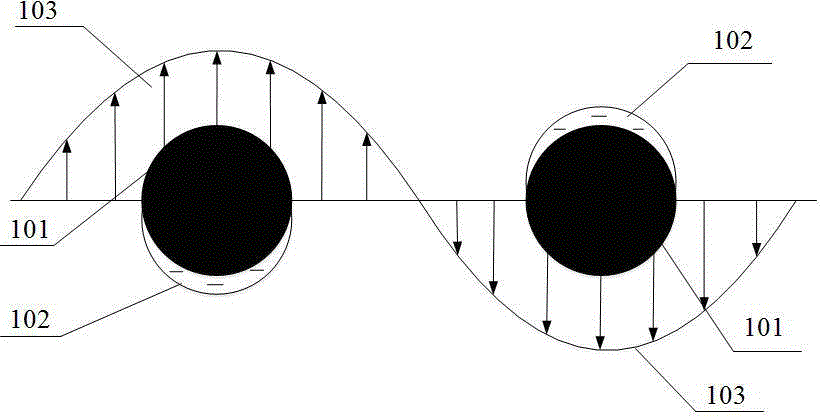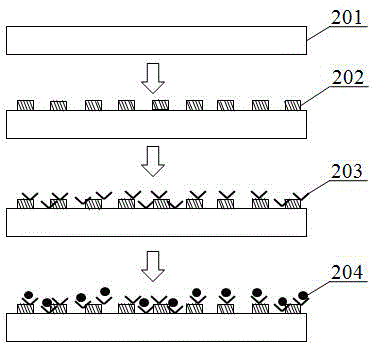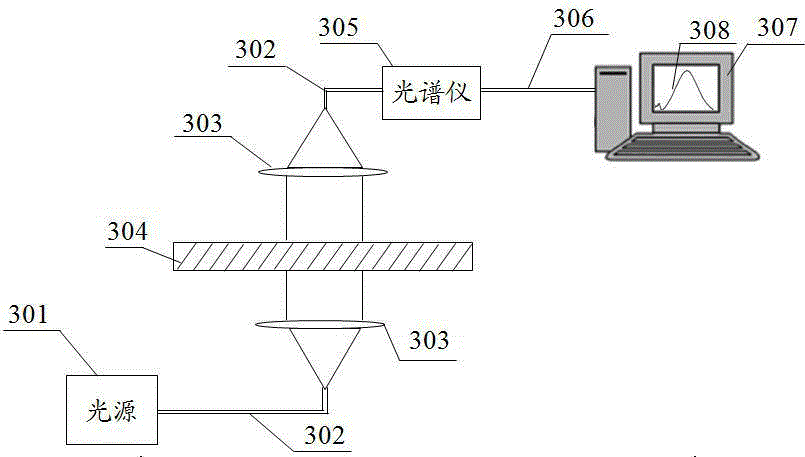Organophosphorus detection method based on LSPR (localized surface plasma resonance)
A plasmon resonance and localized surface technology, applied in measuring devices, material analysis through optical means, instruments, etc., can solve problems such as expensive, not in line with the development direction of integrated low-cost sensors, and complicated metal nanostructure steps , to achieve the effect of simple steps, low miniaturization and low cost
- Summary
- Abstract
- Description
- Claims
- Application Information
AI Technical Summary
Problems solved by technology
Method used
Image
Examples
Embodiment 1
[0080] Utilize the detection method of the present invention to detect trichlorfon, an organophosphorus pesticide, and the detection steps are as follows: Figure 4 shown.
[0081] (1) Step 4-I, preparing an enzyme sensor chip: selecting K9 glass 401 with a size of 10mm×20mm×2mm as the chip substrate, cleaning and drying the substrate. The AChE was immobilized by adsorption method, and the immobilized AChE 402 was obtained on the surface of the glass substrate.
[0082] The cleaning process of the glass substrate is carried out according to the following steps:
[0083] First, soak the K9 glass substrate in 1.2 moles per liter (M) of sodium hydroxide solution and 1.2M hydrochloric acid solution for 5 minutes (min), and then wash it with deionized water; then, immerse it in concentrated hydrochloric acid solution, soak 1min, wash with deionized water; finally, soak in ethanol, acetone and deionized water for 5min respectively; blow dry or dry at room temperature.
[0084] Im...
Embodiment 2
[0090] Embodiment 2, using the detection method of the present invention to detect the simulant dimethyl methyl phosphate (DMMP) gas of sarin poisonous gas, the detection steps are as follows Figure 4 shown.
[0091](1) Step 4-I, preparing an enzyme sensor chip: selecting K9 glass 401 with a size of 10mm×20mm×2mm as the chip substrate, cleaning and drying the substrate. The AChE was immobilized by cross-linking method, and the immobilized AChE 402 was obtained on the surface of the glass substrate.
[0092] The cleaning process of the glass substrate is carried out according to the following steps:
[0093] First, soak the K9 glass substrate in 1.2M sodium hydroxide solution and 1.2M hydrochloric acid solution for 5 minutes, and then wash it with deionized water; then, immerse it in concentrated hydrochloric acid solution, soak it for 1 minute, and wash it with deionized water; Finally, soak in ethanol, acetone and deionized water for 5 minutes respectively; dry or dry at r...
PUM
 Login to View More
Login to View More Abstract
Description
Claims
Application Information
 Login to View More
Login to View More - R&D
- Intellectual Property
- Life Sciences
- Materials
- Tech Scout
- Unparalleled Data Quality
- Higher Quality Content
- 60% Fewer Hallucinations
Browse by: Latest US Patents, China's latest patents, Technical Efficacy Thesaurus, Application Domain, Technology Topic, Popular Technical Reports.
© 2025 PatSnap. All rights reserved.Legal|Privacy policy|Modern Slavery Act Transparency Statement|Sitemap|About US| Contact US: help@patsnap.com



